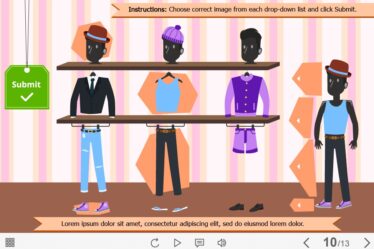
How To Evaluate Employee Performance In Your Customer Service Online Course
Corporate eLearning allows you to rapidly deploy online training resources so that every member of the team has 24/7 access. They can embark on personalized learning paths, watch demos during their moment of need, and periodically assess their skills. However, the LMS isn’t just a place to gather information, but to evaluate employee performance. You’re able to get to the root of low customer satisfaction ratings and slow sales thanks to learning technologies. Here are 7 unexpected ways that you can use in customer service online training to spot gaps and provide performance support before it’s too late.
7 Creative Ways To Measure Staffer Performance In Customer Service Training
1. Persona-Packed Online Training Simulations
Develop online training simulations featuring an entire cast of customer personas ranging from the ever-popular disgruntled customer who wants to return something a year after purchasing to the 20-question customer who inquires about every aspect of a product, only to walk away empty-handed. It will give you the ability to gauge how employees interact with the most common customer concerns and personality types. Plus, they gain real-world experience in the process. Just make certain that the personas have realistic traits, behaviors, and motivations. Remember, you’re trying to evaluate their ability to apply skills and experiential knowledge in a practical context.
2. Pressurized Serious Games
Set the clock, and invite employees to progress through serious games levels. Timed games test their ability to remain calm under pressure. For example, they must identify the customer’s issue and come up with a viable solution in under 2 minutes. Apply just enough pressure to determine how they handle these situations in the workplace without making them feel overstressed. Think of how long it should normally take to deal with similar challenges on the job. For instance, the customer would usually grow impatient after 5 minutes of waiting, given that the problem isn’t that complicated.
3. Troubleshooting Branching Scenarios
Use branching scenarios in your customer service online course to see how well employees can handle problems that arise on the job. It could be anything from dealing with a problematic POS operation to helping a customer who calls in with a product repair question. Survey your team to uncover the most common challenges they face on a daily basis. Then use your findings to develop branching scenarios with a full spectrum of outcomes. The decisions they make help you identify areas for improvement so that you can recommend personalized performance management resources. You should probably pair this with a microlearning online training repository that allows employees to quickly address gaps they disclose during branching scenarios.
4. Personalized Pop Quizzes
There are two ways to approach this evaluation method in your customer service online course. The first is to invite employees to choose pop quizzes that pertain to known gaps. For example, one employee is already aware of a skill gap that slows down customer service tasks. The second route is to survey them beforehand and provide the most suitable pop quiz based on the results. Personalized quizzes are ideal for performance issues that are easily measured. For example, testing their knowledge of a product or compliance issue that ties into a work-related process.
5. Microlearning WWYD Video Demos
Encourage employees to watch an open-ended video demo, then ask them what they would do to reach the most favorable outcome. For example, the brief clip features an employee ringing up a sale or listening to a customer as they express the concerns about a product. After viewing, employees must decide what they might do in the employee’s shoes to keep the customer happy without violating company policy. You can also let the situation play out in the demo video, then ask what they would do differently to achieve better results. This microlearning online training activity helps you not only evaluate their performance but also facilitate self-reflection.
6. Live Event Hosting Gigs
Employees have to know a significant amount of information about an online training topic or task in order to teach it. Let them host their own live events that focus on a specific performance issue, complete with discussion topics, activities, and Q&As with attendees. They must study the task in depth to identify all the key takeaways, then use the information to form a concise walkthrough. This might also reveal hidden areas for improvement. Another approach is to host a live roundtable, wherein employees get to share personal anecdotes. You can even start off with a topic and invite them to share their thoughts or explain how they would handle the customer service challenge.
7. Group Collaborations With Follow-Up eLearning Feedback
Schedule online group collaboration projects that give employees the chance to work with peers and collectively address performance issues. Ask them to develop a presentation based on a common problem they encounter in the workplace, or a task that they think many co-workers struggle with. Working in a team environment helps them identify weak points by comparison. For example, they realize that they’ve been handling a customer issue incorrectly for months and that there’s a better way to resolve the problem. Their coworkers’ insights and unique experiences open their minds to the fact that there is room to improve. Plus, you get to see how they delegate tasks, overcome team conflicts, and manage their team. Which all helps to evaluate their performance and spot trouble areas. Afterward, host a follow-up eLearning feedback session so that their peers can offer an insider’s perspective.
Conclusion
These 7 evaluation techniques can help you diagnose performance issues before they spiral out of control. Which ensures that your employees provide the best possible service and retain your loyal customers. But it also gives you the opportunity to keep your top talent by offering them the self-assessment tools they need to succeed, as they can seek additional support to overcome professional hurdles and be more productive on the job.
Taking your training online offers a broad range of benefits, especially when talking about customer service training. Find the right sales and services eLearning content provider using our exclusive online directory.



